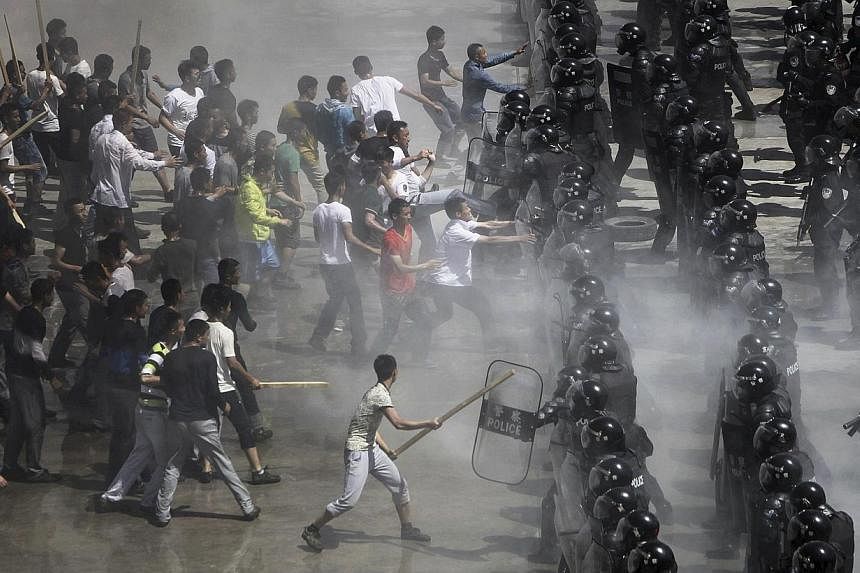I HAVE never paid much attention to Singapore's much-vaunted racial harmony or the Government's constant refrain to cherish it lest we return to the days of the 1960s ethnic riots.
Born in the 1970s, I grew up in a racially harmonious environment: I get along well with classmates, friends and colleagues belonging to other ethnic races, have no problem venturing into Little India or Geylang Serai, and have never witnessed a racially-charged fight or spat.
But a recent reporting trip took me to Xinjiang, a restive region in western China, where I saw clearly what racial strife can do to a place and its people.
More importantly, it made me realise how precious racial harmony is for a state or country, and what Singapore needs to do to protect this asset.
In Xinjiang, whose 22 million- strong population is made up of 40 per cent Han Chinese and 46 per cent Uighurs with the rest being ethnic minority groups like Kazakhs, ethnic strife is most visible in its capital city, Urumqi.
Existing factors like Uighurs' resentment against the Han influx into Xinjiang have long fuelled tentions between the two groups, but relations deteriorated further after July 5, 2009, the day China's worst ethnic violence in decades erupted.
That day, Uighur locals angered by the death of two Uighurs in a clash with Han Chinese in southern Guangdong province, turned against Han Chinese in Urumqi. They went on a killing rampage that left some 200 dead and 1,700 others injured. Two days later, Han Chinese set upon Uighurs in retaliation and more lives were lost.
Since then, the ethnic divide in Urumqi with 3.5 million residents has widened significantly. It is now a city of two halves: Han Chinese in the north and Uighurs in the south, with the South Gate roundabout serving as an unofficial demarcation line.
Residents as far as possible avoid contact with those from the other half. Han Chinese and Uighurs who own shops or live in the same street hardly talk to each other, citing language and cultural barriers, and many say they do not have friends from "the other ethnic group".
Negative stereotypes pop up when one group talks about the other. Han Chinese say Uighurs are lazy and violent while Uighurs call them uncouth and money-minded.
The recent spate of terror attacks in Xinjiang and across China - blamed on Uighur separatists - has further strained ethnic ties.
While some Han Chinese I interviewed said they know the riots and attacks were the work of a small bunch of "bad apples", they readily admitted feeling hostility towards the entire Uighur community.
Ethnic tensions have clearly hit both groups hard. In Urumqi, Uighur eateries have less business because the Han Chinese no longer patronise them. Tourists have also stayed away in case violence breaks out again.
Everyone is suffering, yet no one seems to know how to solve the problem.
As I wandered into Urumqi's Uighur quarters, where most of the Han Chinese were killed during the 2009 riots, and visited predominantly Uighur cities such as Kashgar, I began to think about what Singapore must do to avoid Xinjiang's plight.
There are four things we can do.
First, we must absolutely prevent ethnic enclaves from taking shape in Singapore, such as through the ethnic quota policy for public housing.
Second, it is imperative to deal with the real issues in ethnic relations and nip them in the bud when disputes arise, instead of letting them fester. Some observers say the Xinjiang situation has not improved because the Chinese government refused to admit that its policies did not work, instead blaming the violence on external influences.
Third, we need to maintain grassroots platforms to promote interaction and understanding between races and religions, and to allow healing and reconciliation to take place when conflict arises. Existing mechanisms like the Inter-Racial and Religious Confidence Circles (IRCCs), which are local-level inter-faith platforms tasked to promote racial and religious harmony in every constituency, can play that crucial role.
The common criticism among observers and locals is that the Chinese authorities tried to sweep the 2009 riots under the carpet. They ordered all the physical evidence of a riot having taken place to be removed quickly, but left behind the people's anger and bitterness, which are festering to this day.
Lastly, we must allow public opinion leaders to emerge. These well-respected figures can speak up quickly to correct any falsehood, misunderstanding and extreme views within the community more effectively when the Government's message fails to get through.
Uighurs say the lack of "middlemen" means there is no communication channel between the community and the Chinese government, which relies on Uighur officials, some of whom are dismissed as stooges and not trusted by their own Uighurs.
Scholars keen to speak up are, nevertheless, daunted by the plight of noted Uighur economist Illam Tohti, who was detained this year on separatism charges. Many believe that he is being persecuted for criticising Beijing's ethnic policies.
Indeed, Xinjiang provides us with a sobering reminder of how frail racial harmony is: Some things, once broken, are hard to fix.


